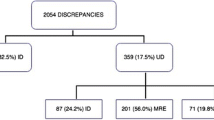Abstract
Background
Medication reconciliation has proved its effectiveness at improving drug-prescription safety. This study was undertaken to assess the impact of an intervention aimed at decreasing the discrepancies between a patient’s usual treatment(s) and medications prescribed at admission.
Methods
Our study was conducted from November 2010 to May 2011. Discrepancies between home medication(s) and drugs prescribed to every patient aged ≥65 years, transferred from the Emergency Department and hospitalized in the Internal Medicine Unit, were analyzed.
Results
During this 6-month period, 170 patients were prospectively included, with a total of 1,515 medicines reconciled. The unintentional discrepancy rate declined from 4.3 to 0.9 % after the intervention. The main sources of discrepancies concerned alimentary tract and metabolism (25.7 %), cardiovascular (24 %), and nervous system drugs (19.4 %).
Conclusions
The results of this study demonstrated that acquisition of patients’ medication history is often incomplete or incorrect. Pharmacists seem to be especially well suited to help medical teams rectify this situation. However, the cost effectiveness of this intervention needs further assessment.

Similar content being viewed by others
References
Canadian Council on Health Services Accreditation CCHSA Patient/Client Safety Goals & Required Organizational Practices. Frequently Asked Questions—Updated June 6, 2005 Ottawa. 2005.
Schuldt LM, editor. Medication reconciliation handbook. 2nd ed. Oakbrook Terrace: Joint Commission Resources; 2009.
Pippins J, Gandhi T, Hamann C, et al. Classifying and predicting errors of inpatient medication reconciliation. J Gen Intern Med. 2008;23(9):1414–22.
No authors listed. Using medication reconciliation to prevent errors. Jt Comm J Qual Patient Saf. 2006;32(4):230–2.
Schnipper JL, Kirwin JL, Cotugno MC, et al. Role of pharmacist counseling in preventing adverse drug events after hospitalization. Arch Intern Med. 2006;166:565–71.
Tam VC, Knowles SR, Cornish P, et al. Frequency, type and clinical importance of medication history errors at admission to hospital: a systematic review. CMAJ. 2005;173:510–5.
Reconcile medication at all transition points. IHI Patient Safety Medication Systems Changes. Cambridge, MA, Institute for Healthcare Improvement. http://www.ihi.org/knowledge/Pages/Changes/ReconcileMedicationsatAllTransitionPoints.aspx. Accessed 15 Jan 2012.
Bartick M, Baron D. Medication reconciliation at Cambridge Health Alliance: experiences of a 3-campus health system in Massachusetts. Am J Med Qual. 2006;21:304–6.
Haig K. Medication reconciliation. Am J Med Qual. 2006;21:299–303.
Vira T, Colquhoun M, Etchells E. Reconcilable differences: correcting medication errors at hospital admission and discharge. Qual Saf Health Care. 2006;15:122–6.
“High 5s” Project, http://www.high5s.org. Accessed 15 Jan 2012.
HAS (French National Health Authority). http://www.high5s.org/bin/view/Main/France. Accessed 15 Jan 2012.
Enquête Nationale sur les Evénements Indésirables liés aux Soins 2009. http://www.securitesoins.fr/fic_bdd/pdf_fr_fichier/12949317630_ENEIS_2009.PDF. Accessed 15 Jan 2012.
Keehan SP, Lazenby HC, Zezza MA, et al. Age estimates in the national health accounts. Health Care Financ Rev. 2004;1(1) (Web Exclusive).
La conciliation des traitements médicamenteux du patient à son admission dans un établissement de santé. Documentary record developed by HAS and EVALOR, January 2010.
Anatomical Therapeutic Chemical Classification System. http://www.whocc.no/atc/structure_and_principles/. Accessed 15 Jan 2012.
National Coordinating Council for Medication Error Reporting Prevention. http://www.nccmerp.org/. Accessed 15 Jan 2012.
van den Bemt PM, van der Schrieck-de Loos EM, van der Linden C, et al. Effect of medication reconciliation on unintentional medication discrepancies in acute hospital admissions of elderly adults: a multicenter study. J Am Geriatr Soc. 2013;61(8):1262–8.
De Winter S, Spriet I, Indevuyst C, et al. Pharmacist versus physician acquired medication history: a prospective study at the emergency department. Qual Saf Health Care. 2010;19(5):371–5.
Dawson P, Gray S. Clinical significance of pharmacist-obtained drug histories. Pharm J. 1981;227:120.
Bond CA, Raehl CL, Franke T. Clinical pharmacy services, hospital pharmacy staffing and medication errors in United States hospitals. Pharmacotherapy. 2002;22(2):134–47.
Nester TM, Hale LS. Effectiveness of a pharmacist-acquired medication history in promoting patient safety. Am J Health Syst Pharm. 2002;59(22):2221–5.
Badowski SA, Rosenbloom D, Dawson PH. Clinical importance of pharmacist obtained medication histories using a validated questionnaire. Am J Hosp Pharm. 1984;41(4):731–2.
Gleason K, Groszek J, Sullivan C, et al. Reconciliation of discrepancies in medication histories and admission orders of newly hospitalized patients. Am J Health Syst Pharm. 2004;61:1689–95.
Karnon J, Campbell F, Czoski-Murray C. Model-based cost-effectiveness analysis of interventions aimed at preventing medication error at hospital admission (medication reconciliation). J Eval Clin Pract. 2009;15(2):299–306.
Cornish P, Knowles S, Marchesano R, et al. Unintended medication discrepancies at the time of hospital admission. Arch Intern Med. 2005;165(4):424–9.
Doerper S, Morice S, Piney D, Dony A, Baum T, Perrin F, Guillaume V, Vidal A, Ferry O, Peter N, Azizi Y, Vouaux V, Rosa D, Dufay E. La conciliation des traitements médicamenteux : logigramme d’une démarche efficiente pour prévenir ou intercepter les erreurs médicamenteuses à l’admission du patient hospitalisé. Pharm Hosp Clin. 2013;48(3):153–60.
Acknowledgments
This work was carried out as part of the High 5s Project initiated by the WHO in 2007 and coordinated by the WHO Collaborating Center on Patient Safety. The Joint Commission in the USA, with the participation of the French Lead Technical Agency, National Health Authority (HAS) partnered with OMEDIT Aquitaine and the High 5s France Medication Reconciliation Study Group.
CT, EP, and PA designed the research. LA, CT, J-FA, CE, AM, EP, PA, and TP conducted the research. LA, CT, J-FA, CE, and EP analyzed the data. CT, J-FA, EP, PA, and TP contributed new reagents/analytical tools. LA, CT, and J-FA wrote the manuscript.
No sources of funding were used to conduct this study or for the preparation of this article.
The authors have no potential conflicts of interest that are directly relevant to the content of this study.
Author information
Authors and Affiliations
Corresponding author
Rights and permissions
About this article
Cite this article
Andreoli, L., Alexandra, JF., Tesmoingt, C. et al. Medication Reconciliation: A Prospective Study in an Internal Medicine Unit. Drugs Aging 31, 387–393 (2014). https://doi.org/10.1007/s40266-014-0167-3
Published:
Issue Date:
DOI: https://doi.org/10.1007/s40266-014-0167-3




